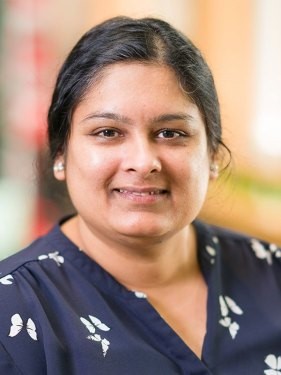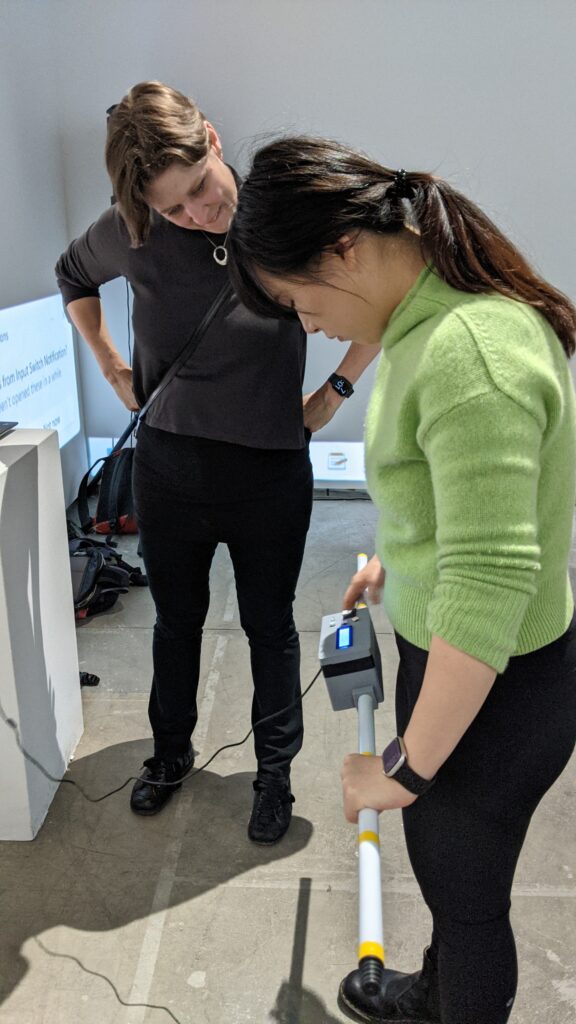
A class run by Shital Desai, a professor the Department of Computational Art in the School of the Arts, Media, Performance & Design and York Research Chair in Accessible Interaction Design at York University, empowers students to create electronic devices with potential real-world impact.
What if teacups could talk or walking sticks could tell a doctor when a patient isn’t doing assigned exercises?

Those scenarios are not a Disney musical, but a reality in Professor Shital Desai’s work and DATT 2010 Physical Computing II class.
Desai explains physical computing as the use of electronics to design tangible, embedded, microcontroller-based interactive systems that can sense the world around them such as human interactions and natural phenomenon, and control outputs such as lights, displays and motors.
“In one semester, students learn the basics of physical computing using Arduinos – an open-source electronics platform to read sensor inputs and turn it into an output such as activating a motor, turning on an LED. It’s a foundation for developing electronics-based interactive products,” said Desai, who teaches interaction design and heads the Canada Foundation for Innovation-funded Social & Technological Systems (SaTS) Lab at York University.
The aim is to help students learn how to solve real-world problems with technological solutions.
Desai’s past work offers an example. To enable a closer connection between family members communicating remotely, Desai designed and built an interactive tea ritual kit.
“People could connect with their grandparents and parents overseas while having their morning cup of tea,” Desai said. “Instead of picking up your mobile phone and making a WhatsApp call or starting a chat, the artefacts which are part of the morning tea ritual, such as the tea caddy and the teacup, were fitted with electronics. And you talk to your loved ones through interactions with the artefacts and you can make that remote communication part of your everyday rituals while having your morning cup of tea.”
Applying a similar approach, in Desai’s most recent Physical Computing II class, she asked students to use the skills and knowledge learned in Physical Computing I to solve a problem in the rehabilitation sphere using a human-centred design approach.
The assignments build on Desai’s ongoing projects in her research lab, with a specific interest in how technology can help patients – such as athletes who have an injury, people with dementia and outpatients who had a stroke – continue rehabilitation exercises in their homes, aiding recovery. She looks at how technologies can support remote rehabilitation and communication with health-care practitioners.
In the Physical Computing class, her students embraced rehabilitative innovation in several ways. One group designed a glove for an athlete who plays volleyball. Another looked at rehab for foot injuries and designed a sock that helps guide those patients’ exercises.
A third group built an exercise stick for older athletes, a FlexiTrainer Pro, that would help rehabilitation patients do upper body exercises properly. The device guides the athletes through their upper body exercises and corrects their technique. After a patient has completed the required repetitions, the device reports the effort and results to the athlete’s health-care provider.

Xiwei “Sylvie” Ma, a digital media student in computational arts in the School of the Arts, Media, Performance & Design who worked on the FlexiTrainer Pro, says the project began by interviewing seniors to understand their journey with everyday rehabilitation exercises and identify barriers to engaging and remaining motivated with the exercises. Then, they built their interactive device that makes a sound when it is held high enough and at the correct angle. When the required number of repetitions are completed, a small screen on the device flashes the word “Congratulations.”
Ma and the FlexiTrainer Pro team have plans to further improve upon their work by potentially adding the ability to choose the level of exercise depending on where the patient is in their recovery process. She also thinks adding motivational cues could help inspire people to do their exercises, an important part of recovery. Ma thought of that approach because of her competitive father, who would be motivated to do his exercises if he could compare his progress to his friends’. Another addition, Ma said, could be gamifying the stick to allow patients to feed an electronic pet on the stick’s screen when they are successful with their exercises, as she noticed in interviews with seniors that pets were very important to them.
The impact of the experiences Desai’s class provides can be seen not just in potential users of the devices created, but in the students. Dohyoung “Dave” Kim, a third-year computer science student in York’s Lassonde School of Engineering who also worked on the FlexiTrainer Pro, enrolled in Desai’s course because he was interested in robotics. He came out of the course with renewed clarity about his career plan, going from feeling unsure about where to take his general interest in computer science to being certain he wants to work in the area of embedded systems – computational devices with hardware and software dedicated to a single function.
“Everything is composed of embedded systems – in laundry, in microwave, in robotics, in your car … they make devices work,” Kim said. “That’s how I got the idea and the interest to build my career with it.”
This project was executed in three design programs in three different countries, with the course directors collaborating to deliver the courses and provide disciplinary and expert feedback to the students, Desai said. This collaborative initiative, called Global Design Studio, was funded by York’s Global Networked Learning Grant. The initiative has also informed the Toolkit for the Interdisciplinary Infusion of the United Nations Sustainable Development Goals into Classrooms. Desai’s international colleagues are Professor Suzan Boztepe at Linköping University in Sweden, Professor Marianella Chamorro-Koc at Queensland University of Technology in Australia and Professor Ingrid Stahl at Technische Hochschule Ingolstadt in Germany. Desai also acknowledged the work of York University Professor Jane Tingley, who developed the Physical Computing course over the years. Those resources were very helpful in teaching foundational skills to students in physical computing, Desai said.
